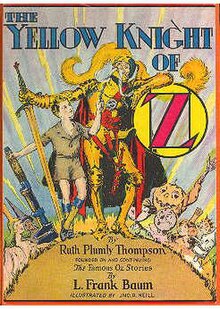The Yellow Knight of Oz

Cover of The Yellow Knight of Oz
|
|
| Author | Ruth Plumly Thompson |
|---|---|
| Illustrator | John R. Neill |
| Country | United States |
| Language | English |
| Series | The Oz books |
| Genre | Fantasy |
| Set in | Land of Oz |
| Published | 1930 by Reilly & Lee |
| Media type | |
| Pages | 275 pp |
| OCLC | 2112060 |
| Preceded by | Jack Pumpkinhead of Oz |
| Followed by | Pirates in Oz |
The Yellow Knight of Oz (1930) is the twenty-fourth in the series of Oz books created by L. Frank Baum and his successors, and the tenth written by Ruth Plumly Thompson. It was illustrated by John R. Neill.
Sir Hokus of Pokes grows bored with life in the Emerald City, and he and the Comfortable Camel set out for some adventure. Sir Hokes wants to rescue a damsel in distress, or at least find a monster to fight. Sir Hokus visits Marshland and befriends Ploppa, a giant mud turtle. Ploppa would like to accompany Sir Hokus on his adventures, but cannot leave the swamp. Sir Hokus is joined by the Comfortable Camel.
Meanwhile, a boy named Speedy blasts his way to Oz in a homemade rocket ship, where he finds himself in the underground kingdom of Subterranea. At his touch, a golden statue of a beautiful girl comes to life. She is called Marygolden, and she accompanies Speedy on his further adventures. Sir Hokes and Speedy join forces and, using the power of a bag of magic dates, they counter the magic of the evil Sultan of Samandra and restore the Corumbian Kingdom, which the Sultan had conquored and enchanted. Sir Hokus learns his true identity: he is actually the young and handsome Yellow Knight of Corumbia, transformed into old, absent-minded Sir Hokus by the Sultan's magic. Using the power of the magic dates, Sir Hokus regains his youthful form and vacates the Emerald City to rule as Prince of Corumbia.
L. Frank Baum adapted many of his Oz stories for stage and film versions, but The Yellow Knight of Oz is the only one of Thompson's Oz books that was adapted for the stage. In 1962, Sacramento theater manager Richard Fullmer obtained permission from Thompson, publisher Reilly & Lee, and the Baum estate to adapt the book. (Fullmer had previously produced his own adaptation of Baum's original Wizard of Oz.) Fullmer's version was premiered at the Sacramento Civic Theater in February 1963; it blended live actors with puppets for non-human characters like the Comfortable Camel.
...
Wikipedia
